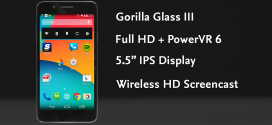 Today we’ll be taking a look at the HTC One V. The HTC One V is part of the HTC One series, which has proven to be quite a good series. This one is one of the lower budget phones, or at least it should be considering that its specifications are quite up to par on all ends with the standards set by the day and age in which this phone chose to come out in. Still, that only my opinion and let it not influence your own. Instead, keep reading and see what you make of this phone.
Today we’ll be taking a look at the HTC One V. The HTC One V is part of the HTC One series, which has proven to be quite a good series. This one is one of the lower budget phones, or at least it should be considering that its specifications are quite up to par on all ends with the standards set by the day and age in which this phone chose to come out in. Still, that only my opinion and let it not influence your own. Instead, keep reading and see what you make of this phone.
You can get HTC One V from Amazon.
GENERAL
We’ll start this little review off by taking a look at some of the more general aspects of the HTC One V. Here we can find out a bit of info about the supported networks as well as the announcement and release dates of the HTC One V. This phone supports both 2G and 3G networks. The 2G ones are : GSM 850, GSM 900, GSM 1800 and GSM 1900. As mentioned before, it also supports 3G ones : HSDPA 850, HSDPA 900 and HSDPA 2100. The HTC One V was announced somewhere in February 2012, only to be released a bit later in April 2012. Well, that’s enough said about the generals, so let us move on to the body of the phone.
BODY
Next up we will take a brief look at the aspect of the device. Here we can find out a thing or two about the size, the weight as well as whether or not the device has any other distinguishable facts that we should be aware of. The HTC One V is around 120.3 x 59.7 x 9.2 mm big. That isn’t all that big, but then again : it does seem to have a component which I can’t really find much use for. I’m referring to that small part right under the screen. It’s a relatively tilted plastic part with no apparent use or function. Still, for design’s sake, we’ll leave it at that. The HTC One V weighs somewhere around 115 grams. This phone also hsa Touch-Sensitive Controls instead of buttons, which may be preferred by some people. That would be it for the body, let us now move on to the display.
DISPLAY
Here we are at the display of the HTC One V. In this part we can find out a bit about the type of screen of the HTC One V, the screen size, the screen’s pixel density and its resolution, as well as find out if the phone has any screen protection on it or any enhancements installed on it, no matter their nature. The HTC One V has a capacitive touchscreen with 16 million colors. I wish I could tell you what type of screen it has EXACTLY, but it isn’t specified. The screen of this device is around 3.7 inches big and can house a resolution of approximately 480 x 800 pixels. The pixel density of this screen is around 252 ppi, which is more than good enough by my standards. While some claim that it is only good above 300 ppi, I disagree and say that there is little difference between 250 and 300. The untrained eye can barely even realize they’re different. The HTC One V also has Multitouch, however, it has no screen protection on it. This phone also has HTC Sense UI v4.0 installed on it, should you choose to activate it. Let us now move on to the audio review of the HTC One V.
SOUND
Now we’ll take a quick look at the audio output capabilities of the HTC One V. Here you can find out a thing or two about the alert types of the device, the speaker and audio jack as well as whether or not the HTC One V has any software based sound enhancements or stuff like that. The alert types of the HTC One V are : Vibration, MP3 and WAV ringtones. The HTC One V also has a Loudspeaker and a 3.5 mm jack. Sadly, it has no other sound enhancement or anything, so I guess you could call this device pretty basic as far as sound is concerned. Let us now move on to the memory of the HTC One V,
MEMORY
Next up we’ll be taking a look at the memory of the HTC One V. Here we can find out a bit about the RAM, the internal storage space and whether or not it has any possibility of upgrade. The HTC One V has 512 MB of RAM. Its internal storage space is around 4 GB and this phone also has a Micro SD card slot which can use anything as long as it doesn’t exceed 32 GB. That’s enough for the memory, so let’s move on to the connectivity of the device.
DATA CONNECTION
Next up we’re going to take a brief look at the data connectivity of the HTC One V. Here we can find out a bit of info about the GPRS and EDGE of the device, the Speed and WLAN of the device and the Bluetooth and USB connections. The HTC One V has both GPRS and EDGE, however it isn’t specified what Class they both are and what speed they can reach in MB/s. Same goes for the Speed of the device. We know for sure that it has both HSDPA and HSUPA, but not how many MB/s they each can reach. The WLAN of the device is a Wi-Fi 802.11 b/g/n with Wi-Fi Direct and Wi-Fi hotspot. The HTC One V has a Bluetooth v4.0 connection with A2DP. This phone’s USB port is a Micro USB v2.0 one. Enough about the connectivity of the device. Let us now take a look at the camera
CAMERA
Next up we’ll be taking a look at the camera of the HTC One V. Here we can find out a bit of info about the main and secondary cameras ( if any exist ) as well as their features and capabilities. The HTC One V has a 5 MP frontal camera. This camera is capable of photographing at around 2592 x 1944 pixels. This camera’s features include : autofocus, LED flash, simultaneous HD video and image recording, geo-tagging and face and smile detection. The HTC One V’s main camera is capable of recording video in HD 720p, which is a rare feat among 5 MP cameras. Sadly, the HTC One V has no secondary frontal camera. Since there is nothing more left to say, let us move on to the next part – battery.
BATTERY LIFE
Time to take a brief look at the battery of the HTC One V since batteries are usually a big problem for such devices. Here you can find out a bit of info about the HTC One V’s battery and how long it can function. The HTC One V has a Standard Li-Ion 1500 mAh battery. Sadly, it isn’t specified how long it can function, so we’ll skip that part. Since there is nothing left to say, let’s take a look at the hardware of the HTC One V.
HARDWARE
Next up we’ll review the hardware of the HTC One V. Here you can find out a bit of info about the three main hardware components : processor, motherboard and graphics card. The processor of the HTC One V is a Single Core 1 GHz processor. This device also has a Qualcomm MSM8255 Snapdragon chipset and an Adreno 205 GPU. All and all, this is a relatively weak configuration by our standards, but what can you do. Hopefully, the price won’t be that big either. Let us now move on to the software of the HTC One V.
SOFTWARE
Next up we have the review of the software of the HTC One V. Here you can find out what version of OS the HTC One V has and whether or not it can be upgraded. The HTC One V has Android OS v4.0 Ice Cream Sandwich installed on it. Needless to say, this is the final version of Android OS ( up till now ) so there is no apparent need for an upgrade. Let’s now move on to the final part of the review.
FEATURES
Last but least, we will review some of the more random features and capabilities of the HTC One V. The sensors of this phone are : Accelerometer and Proximity. The HTC One V’s messaging is done via : SMS ( with Threaded View ), MMS, E-Mail and Push Mail. The HTC One V’s browser uses HTML and has integrated support for Adobe Flash. The HTC One V has a Stereo FM radio with RDS and a GPS with integrated A-GPS support. This phone also has Java via Java MIDP emulation. The HTC One V is available in : Black and Brown.
Here is a brief list of what the HTC One V can do :
- Beats Audio
- SNS integration
- MP4/H.263/H.264/WMV player
- MP3/eAAC+/WMA/WAV player
- Google Search, Maps, Gmail, YouTube, Calendar, Google Talk
- Document viewer
- Voice memo/dial
- Predictive text input
This concludes our little review of the HTC One V. If you feel that anything is lacking from this review feel free to leave your suggestions in the comment section below for things which should be added and I will be sure to take them into consideration when writing my future projects. In the meantime, I sincerely hope you had as much fun reading my little review as I had writing it.
You can get HTC One V from Amazon.









